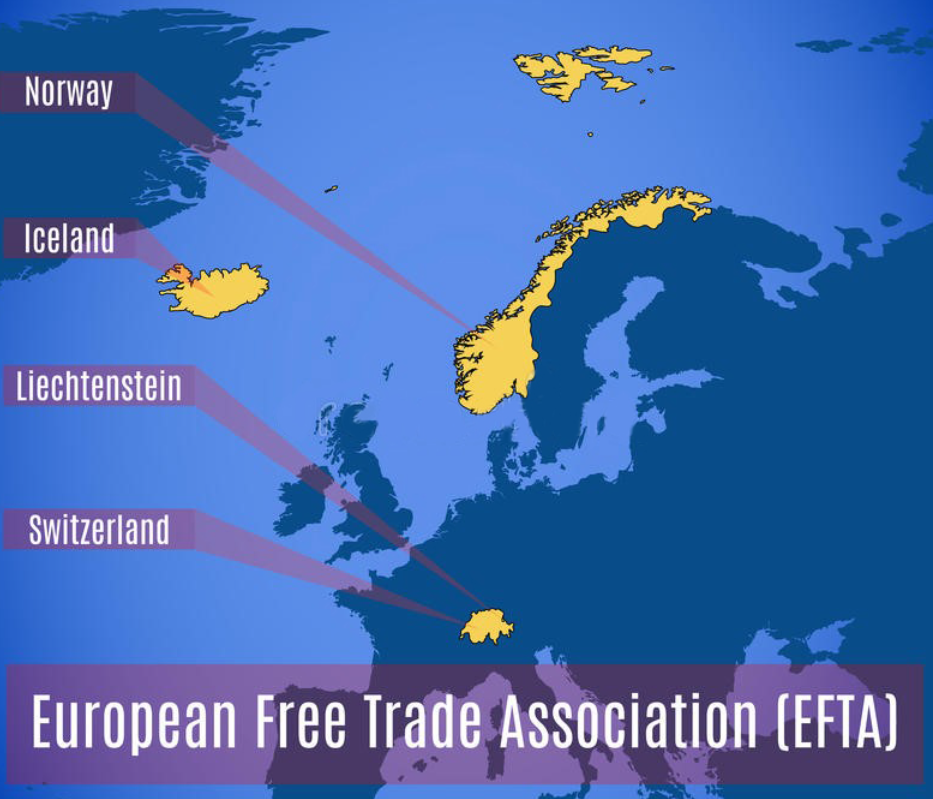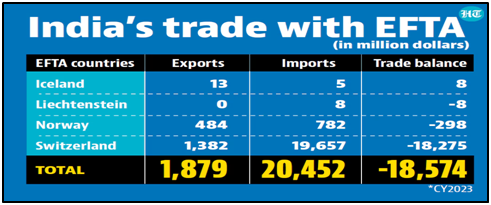CONTENTS
- The TEPA with EFTA is a Major Breakthrough
- The Inflation-Consumption- Growth Triangle
The TEPA with EFTA is a Major Breakthrough
Context:
Earlier this week, India took a significant step by signing a trade agreement with four European countries, signaling a fresh direction in its policy stance. The Trade and Economic Partnership Agreement (TEPA) with the European Free Trade Association (EFTA) members—Switzerland, Iceland, Norway, and Liechtenstein—is noteworthy as it represents India’s first such pact with developed Western nations.
Relevance:
GS2- International Relations-
- Bilateral, Regional and Global Groupings and Agreements involving India and/or affecting India’s interests.
- Important International Institutions, agencies and fora – their Structure, Mandate.
Mains Question:
Analysing India’s trade with the European Free Trade Association (EFTA) members, discuss the significance of the recent Trade and Economic Partnership Agreement. (15 Marks, 250 Words).
European Free Trade Association:
- The European Free Trade Association (EFTA) is an intergovernmental organization established to promote free trade and economic integration for the benefit of its four Member States – Iceland, Liechtenstein, Norway, and Switzerland – as well as their trading partners worldwide.
- EFTA was formed through a Convention signed in Stockholm on January 4, 1960, with the aim of providing an alternative trade bloc for European states that were either unable or unwilling to join the European Economic Community (EEC), the precursor to the European Union (EU).
- The primary responsibilities of EFTA include maintaining and enhancing the EFTA Convention, which governs economic relations among its four member states, managing the Agreement on the European Economic Area (EEA Agreement) that establishes a single market encompassing the EU Member States and three EFTA States (Iceland, Liechtenstein, and Norway), and expanding EFTA’s network of free trade agreements globally.

India and EFTA:
- In terms of trade relations between India and EFTA countries, India’s exports to EFTA nations totaled USD 1.92 billion in 2022-23, while imports amounted to USD 16.74 billion during the same period.
- Bilateral trade between India and EFTA reached USD 18.65 billion in 2022-23, with Switzerland emerging as India’s primary trading partner, followed by Norway.
- Notably, India experiences a trade deficit with Switzerland, primarily due to gold imports.
- In March 2024, India and the European Free Trade Association signed a Trade and Economic Partnership Agreement (TEPA), marking a significant milestone in their economic cooperation.

About the TEPA:
- The Trade and Economic Partnership Agreement (TEPA) is an accord designed to foster trade and investment opportunities between India and the European Free Trade Association (EFTA) by eliminating or reducing tariffs and non-tariff barriers across a wide spectrum of products.
- Its objectives include ensuring equitable and transparent market access conditions for service providers and investors, as well as enhancing collaboration on the protection and enforcement of intellectual property rights.
- Additionally, TEPA seeks to streamline trade procedures, bolster customs cooperation, and establish effective mechanisms for dispute resolution.
- Comprising 14 chapters, TEPA covers various aspects such as trade in goods, rules of origin, intellectual property rights (IPRs), trade in services, investment promotion and cooperation, government procurement, and technical barriers to trade and trade facilitation.
- Noteworthy highlights of the agreement include EFTA’s commitment to promoting investments aimed at increasing the stock of foreign direct investments by USD 100 billion in India over the next 15 years, thereby facilitating the creation of one million direct jobs.
- This commitment marks the first instance in the history of Free Trade Agreements (FTAs) where a legal obligation is made towards targeted investment promotion and job creation.
- EFTA’s market access offer encompasses 92.2% of its tariff lines, covering 99.6% of India’s exports. Conversely, India is offering access to 82.7% of its tariff lines, covering 95.3% of EFTA exports, with the effective duty on gold remaining unchanged. EFTA’s market access offer also includes tariff concessions on Processed Agricultural Products (PAP).
- India has put forward 105 sub-sectors to EFTA and has secured commitments in 128 sub-sectors from Switzerland, 114 from Norway, 107 from Liechtenstein, and 110 from Iceland.
Significance of the TEPA:
- It’s important to note that India has been actively pursuing trade agreements, particularly with Western counterparts like the European Union, the United Kingdom, and eventually, the United States, for quite some time.
- However, negotiations with these Western nations have been notoriously intricate, given the divergent priorities involved, and have failed to materialize into substantive agreements over the decades.
- India’s external economic policy, recently has leaned towards prioritizing domestic sectors over integrating with the global trade framework.
- This stance has raised concerns about the government’s perceived protectionist tendencies, which, in simpler terms, entail shielding inefficient domestic industries through government interventions.
- This approach has sometimes resulted in domestically produced goods and services being of lower quality and higher cost.
Other Multilateral Engagements:
- India’s departure from the Regional Comprehensive Economic Partnership (RCEP), a significant multilateral trade deal involving ASEAN members and countries such as Australia, China, Japan, and South Korea, occurred following numerous rounds of negotiations.
- The rationale behind this move was India’s concern over the disproportionate benefits accorded to China within the agreement, leaving limited scope for India’s economic growth, investment inflows, job creation, and export expansion. However, a shift in India’s trajectory began during the current government’s second term, which commenced in 2019.
- Amidst a global trend towards protectionism, exacerbated by the COVID-19 pandemic, the Ukraine conflict, and tensions in the Middle East, India swiftly negotiated and finalized two early-stage trade agreements with the UAE and Australia.
- This swift action sent a signal to the international community that India is open to negotiation at the trade table, leveraging its status as the fifth-largest economy to further integrate into the global economy. However, such integration is contingent upon terms that ensure mutual benefit for all parties involved.
Ongoing Discussions:
- Presently, India is engaged in extensive negotiations with the UK towards forging a free trade agreement (FTA), which was poised to be a notable achievement for the current government’s economic agenda. However, the finalization of this agreement has been delayed due to various geopolitical considerations.
- The trade agreement with the UAE not only facilitated discussions for a comparable deal with the Gulf Cooperation Council, of which the UAE is a key member, but the ongoing crisis in West Asia might postpone these negotiations.
- It’s noteworthy that the Free Trade Agreement (FTA) with Oman has demonstrated commendable results under the Commerce Ministry’s purview.
- Refocusing on the Trade and Economic Partnership Agreement (TEPA), the Commerce Minister has emphasized its potential to invigorate the Make in India initiative and provide opportunities for the country’s young and skilled workforce.
Conclusion:
TEPA hinges significantly on an approximately $100 billion investment pledge from EFTA members over a fifteen-year period, which could establish a crucial standard and framework for similar agreements with other developed nations. While India and the EU have taken strides towards a potential free trade agreement, negotiating with the union’s 27 member states may present additional complexities. India’s message, amidst experiencing periods of robust growth despite global challenges, is unequivocal: the domestic market is open for business, and Indian exporters are poised to compete globally.
The Inflation-Consumption-Growth Triangle
Context:
The most recent data on retail inflation once again highlights the persistent volatility in food prices, which not only impacts overall inflation but also poses a significant challenge to the cornerstone of economic growth, namely personal consumption.
Relevance:
GS3- Indian Economy-
- Fiscal Policy
- Inclusive Growth
- Banking Sector and NBFCs
- Planning
- Government Budgeting
- Growth and Development
Mains Question:
Analyse the reasons behind the recent trend of headline inflation in India Also discuss its impact on personal consumption and economic growth. (15 Marks, 250 Words).
Headline Inflation:
- The term “headline inflation” refers to the basic inflation rate reported by the Consumer Price Index (CPI), which is issued monthly by the Bureau of Labor Statistics.
- Headline inflation is presented without any adjustments to eliminate highly volatile factors, such as those that can fluctuate independently of economic trends.
- This primary inflation measure is typically associated with changes in the overall cost of living, offering valuable insights to consumers navigating the marketplace.
- The headline figure does not undergo adjustments for seasonal variations or for the frequently unstable components of food and energy prices, unlike the core Consumer Price Index (CPI).
On the Inflation Data:
- While the headline Consumer Price Index (CPI) for February remained relatively stable compared to the previous month, at 5.09%, the rate of increase in food prices, as measured by the Consumer Food Price Index, rose by 36 basis points to 8.66%.
- Of particular concern are vegetable prices, with this category experiencing a substantial 30.3% year-on-year inflation, marking a troubling acceleration of 315 basis points from January’s figures.
- Cereal prices, which hold the largest weight among food items in the CPI, also remained elevated at 7.6%, only slightly lower than the previous month’s 7.83%.
- Within the vegetable category, the trio of potatoes, onions, and tomatoes, which are widely consumed nationwide and represent over a third of the category’s weight, saw significant price increases.
- Potato prices shifted from nearly a 2% year-on-year decrease in January to a 12.4% inflation, while onion prices surged by 22.1%, and tomato prices spiked to a six-month high of 42%, an increase of close to 400 basis points.
- Data from the Department of Consumer Affairs’ daily price monitoring dashboard indicates little relief, with average retail prices of potatoes, onions, and tomatoes standing 21.3%, 41.4%, and 35.2% higher, respectively, as of March 14 compared to a year earlier.
Additional Concerns:
- Evidently, the government’s efforts to address supply-side issues, such as the three-month-old ban on onion exports, have failed to significantly lower prices of these politically sensitive food commodities.
- Moreover, the future outlook is not promising. According to the Ministry of Agriculture and Farmers Welfare’s First Advance Estimates released on March 7, onion production for the 2023-24 horticulture crop year is expected to decrease by more than 15.6% compared to the previous year, while potato production is projected to experience an approximately 2% shortfall.
- Additionally, data from the Central Water Commission reveals that live storage in 150 reservoirs nationwide as of March 14 stands at 40% of capacity, lagging behind both the 10-year average and last year’s levels. This situation is particularly concerning for summer-sown crops, especially in the southern region where the storage deficit compared to the 10-year average is a significant 29%.
- Deputy Governor of the Reserve Bank of India succinctly highlighted the economic risks posed by persistently high food inflation in his statement to the Monetary Policy Committee last month. He noted that private consumption, which contributes to 57% of GDP, is struggling due to elevated food prices, particularly impacting rural areas.
Conclusion:
The importance of curbing inflation to achieve inclusive and sustainable economic growth is well known. With the country heading into elections, policymakers face a challenging task ahead to prevent discontentment, especially if the economy continues to grapple with these issues.



